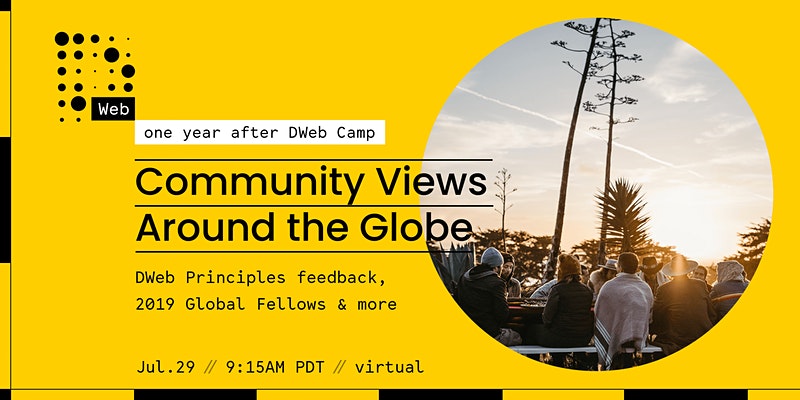
People’s access to accurate, reliable information is always essential. Of course, it becomes ever more critical during a global pandemic like COVID.
But giving people “internet access” alone is not enough. For information to be useful to people, the means of access cannot be a one-way street. Information is social. Information must be contextualized. What are the spoken languages, levels of reading literacy, ways of life, and the legacies of systemic oppression? Community networks take a holistic approach to information and communication technology. Instead of seeing people as passive users, people are active participants, co-creating media through collaborative processes, thereby making it more inherently more accessible than content produced elsewhere.
These are some of the main takeaways from the DWeb Meetup on July 29, 2020. Four DWeb Camp 2019 Global Fellows shared how their community networks in South Africa, Brazil and India are adapting to COVID. Though they can connect to the World Wide Web, the fact that these networks maintain steady connectivity between local nodes with locally-hosted content is in many ways more valuable than their internet access.
So how do their community networks steward connectivity and information in this way? How do they work with their communities to produce local knowledge that feeds their networks?
Community Networks Contextualize Information
Sol Luca de Tena, director of Zenzeleni Networks Non-Profit Corporation (NPC), spoke with us from Cape Town, South Africa. Zenzeleni Networks supports and seeds cooperatively-owned community networks. There are currently two community networks, Zenzeleni Mankosi Cooperative and Zenzeleni Zithulele Cooperative. Together they cover 19 villages and are the first legally-recognized community networks that are owned and governed by their members in South Africa.
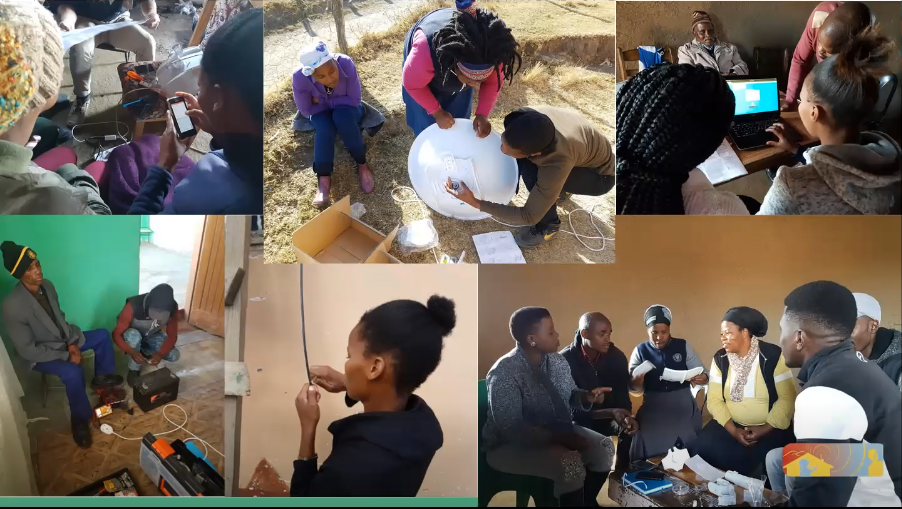
She described how the problem in rural South Africa went beyond having access to reliable information. The public health information regarding COVID was not even useful given the realities of people, especially given that it was not even available in their languages:
“So imagine in your [urban] setting, all the [COVID safety] guidelines that are being published by the government and by doctors, are about how to stay safe when using a communal tap. How to stay safe when taking your cattle out, or tending for your crops. Amidst the anxiety of knowing what to do, what’s real, what’s not. When the information is not contextual, and it’s not even in your first, or second, or third language, imagine the strain that creates.”
The Zenzeleni community networks serve areas where, over the last decade, its network was largely built alongside its energy infrastructure. Its lack of public services and infrastructure was a direct legacy of underdevelopment due to the Apartheid regime. When national and international health guidelines on COVID assume access to running water and other amenities, it just was not helpful or relevant.
“Our Stories, Our Internet”
Two of Zenzeleni’s initiatives were started to address this. The first was the Digital Community Notice Board. Though they had already zero-rated many websites for health and educational resources, they were finding that it was difficult to filter and make sense of it. The Notice Board curates information from credible sources, carries videos in local languages, and empowers people to filter information that is relevant to them.
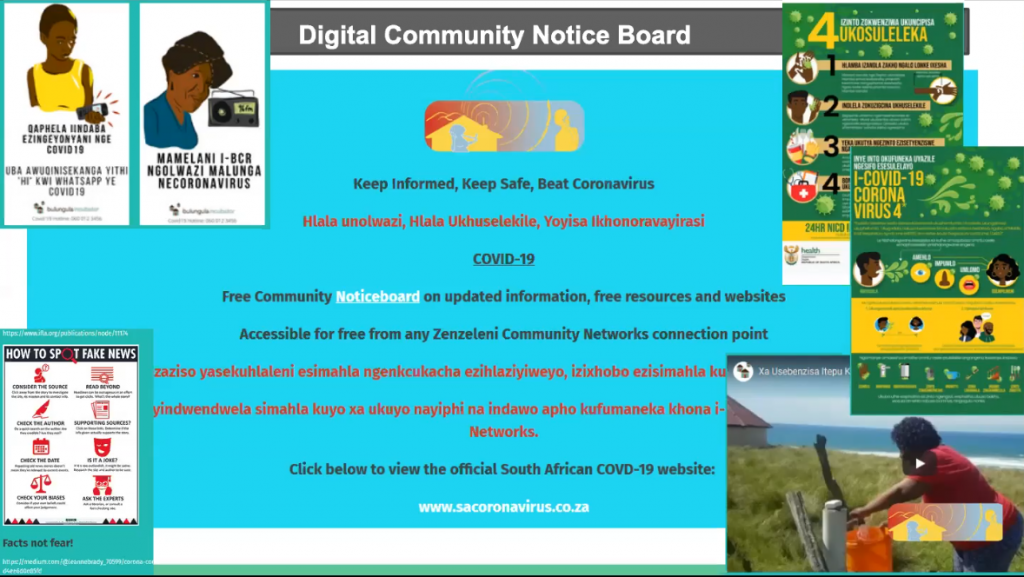
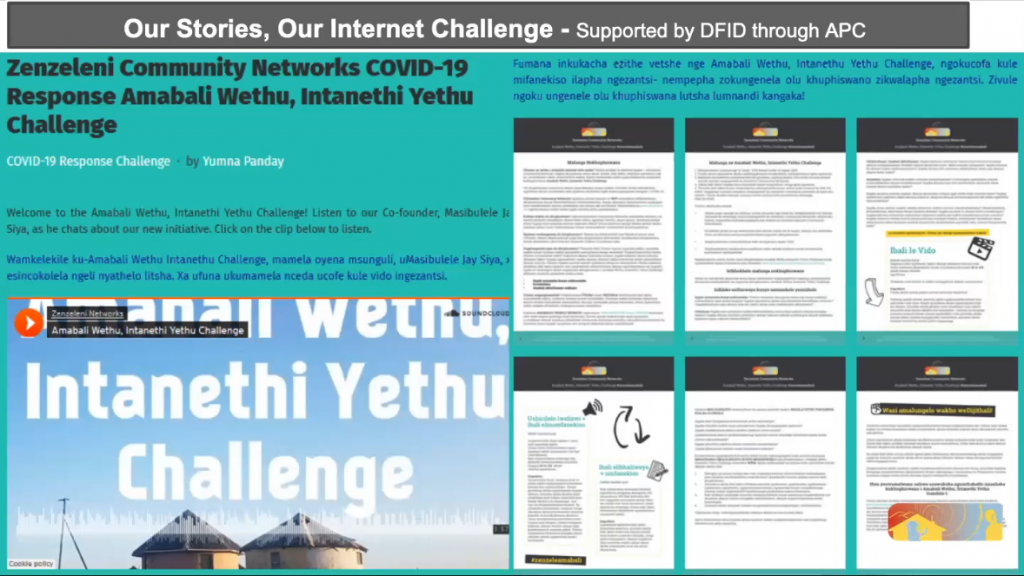
The second project Sol shared with us was Amabali Wethu, Intanethi Yethu (“Our Stories, Our Internet”) Challenge. It came out of the need for more content that is locally-created by indigenous black community members. The challenge calls for content in audio and visual formats and makes the content freely available on the networks across 65 hotspots. Those who create the works can win cash prizes to incentivize people to contribute and help people financially.
Sol emphasized that we need to think about tech as being not separate from people’s lives. The internet is a means to an end, not an end unto itself. Our networks ought to come out of our communities, and be designed according to actual felt needs.
Nodes that Bond
Marcela Guerra joined us from Monteiro Lobato, in the Brazilian state of Sao Paulo. She helps with her neighborhood association, Portal Sem Porteiras, whose main project is operating a local community mesh network. The network uses Altermundi’s Libre Routers for its 18 nodes and has over 200+ devices connected. They use Pirania, a captive portal system also built by Altermundi, to moderate the use of the network and gather micropayments to help pay for the ISP connection.
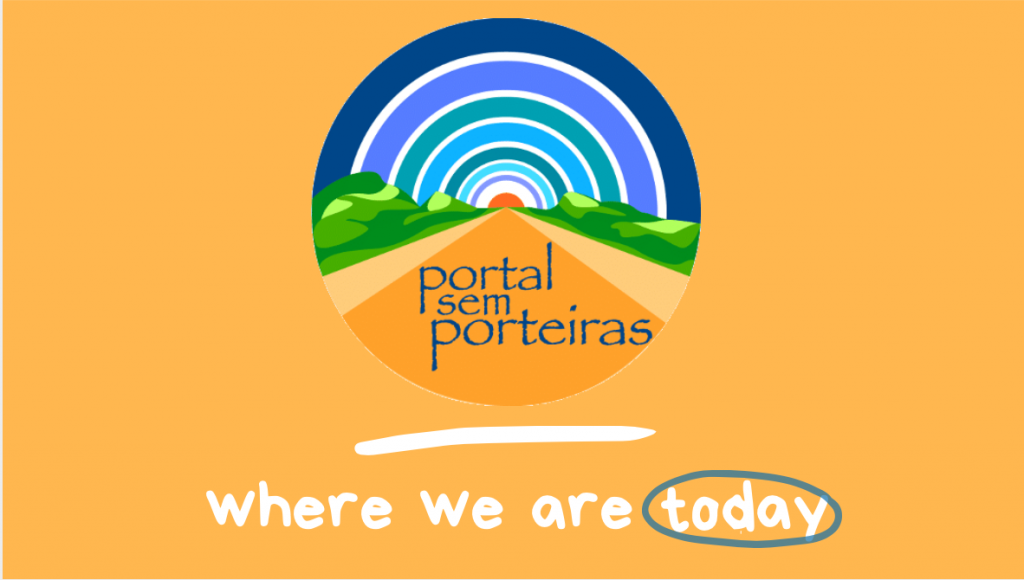
Marcela discussed the organizational hurdles of maintaining the network. With more than 12 people volunteering to maintain it, they made big changes to the way they organized themselves and have made its management more decentralized. They split themselves into five territories, where each group of volunteers is responsible for the connectivity issue of each area’s network.
But as a community network, she said, the work can get very personal. Marcela said that neighbors often knock on the doors of network maintainers when they need internet connection. So they created a virtual channel with a made-up character to help answer those queries. A person is actually answering them behind the scenes, but the character helps to prevent people from getting attached to specific people.
Of course, since all the volunteers are members of the communities themselves, it can be difficult to manage their time and priorities when you live there 24 hours a day, seven days a week. Marcela said that they’re trying to get more involved and are working on better governance so they can consider all their members’ perspectives and adapt as best they can.
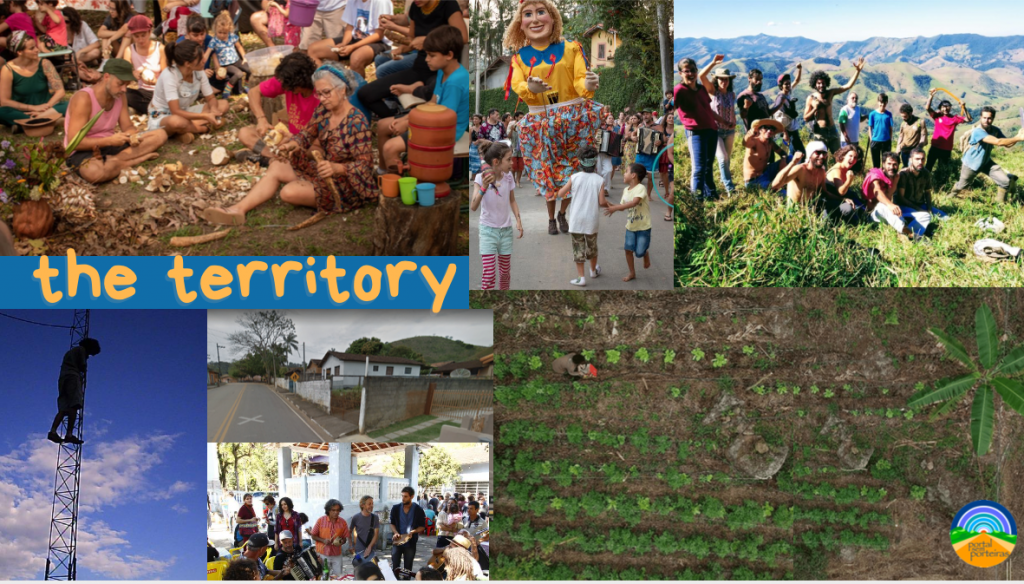
In the meantime, they are opening a new physical location, a hub, for their community network. It’s a well-ventilated house where people can exchange knowledge and take care of personal business — to pay their bills, use a printer, and other tasks people need specialized devices to do.
The other project Marcela coordinates is called Nodes that Bond, which works to shift women’s relationships with technology. They used to have in-person monthly women’s circles to build trust and connection with each other, which was important as they shared personal stories and shaped what they wanted to be able to do with their community network.
Since the pandemic began however, they replaced the women’s circles with a podcast that collects testimonials on various subjects. Some of the episodes help women navigate tech documentation, and others help them as they go through a digital security orientation. She is now working with her team on an audio novella based on research from 2019 about local women’s stories of domestic violence. In order to anonymize the women’s identities, the novella will weave those into one story of a fictional woman.
Marcela combines creativity and practical approaches to ensure her local network is both sustainable and accessible to the women and underserved in her community.
Scrap Laptops + Raspberry Pis + Kolibri
Hiure Queiroz, tech lead of Coolab, supports the creation and maintenance of community networks in his local area. Like most places in the world, education in his community has been hugely impacted by COVID. He talked about how he is using the local mesh (which Marcela mentioned runs on Libre Routers) to provide educational resources to students.
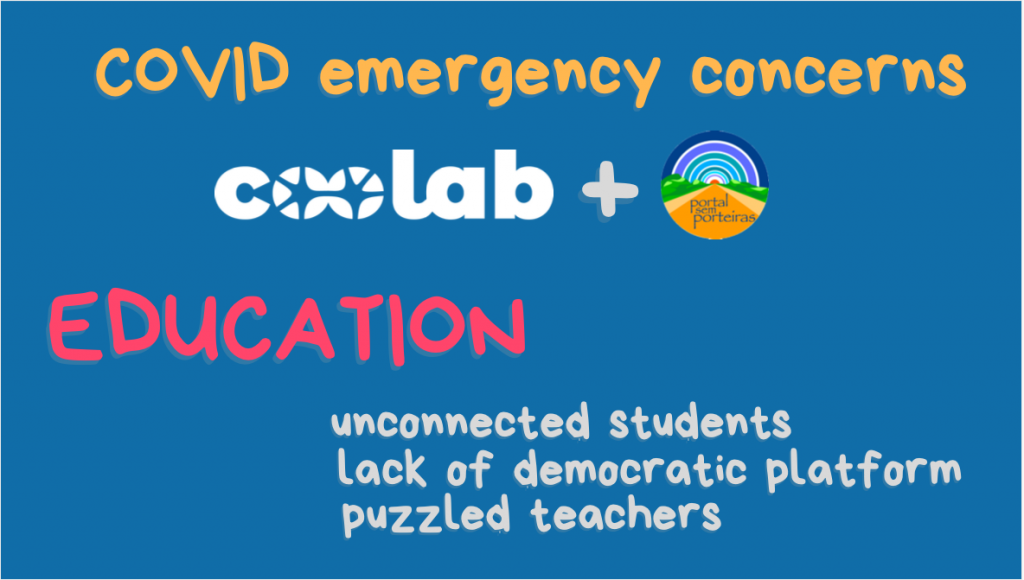
Hiure is relying on Kolibri, an offline educational application built by Learning Equality, which he said was the best app he found for peer-to-peer networks. He is equipping scrapped laptops with Raspberry Pis to wirelessly mesh the devices to build the peer-to-peer network. He named these devices “Frankenberries”. Students and teachers can then use the Frankenberriess to access the educational materials on Kolibri.

Previously, students had to read and access educational materials on their parents’ mobile phones. With the Frankenberry laptops, students can more easily read and interact with the materials. Hiure is holding study groups with students and teachers to train them in using this system.
In order to meet the urgent educational needs of his community under COVID, Hiure is building devices and fashioning them with the materials teachers require to teach their students. Just as important to this is the training he is holding to onboard them.
Building Local Knowledge with Hypermedia and Mesh Mash Networks
Last but not least was TB Dinesh, who presented his work with Janastu, and Servelots. He is building free and open source technologies to address the needs of populations in the Global South, particularly indigenous communities and those experiencing systemic inequity and prejudice. Dinesh’s passion is building the tools for a truly inclusive Web, one that takes into account that still a large population of the world have low reading literacy.
Dinesh is based in a village that lies on top of a hill next to a valley, about one hour from the city of Bangalore in India. A mesh network connects his village to other villages across the valley.

Janastu has built a radio storytelling platform atop that mesh network, enabling people to share their stories and knowledge using audio and visual media. They converted old phone booths into nodes for the radio, called Namdu1Radio. They are equipped with Raspberry Pis that allow people to walk up to listen to other people’s recordings or record their own with a push of a button. Dinesh noted that making the technology approachable this way is crucial. By making use of familiar infrastructure, like a phone booth, you can more easily embed new technology.

But archiving this material in ways that low literacy people can contribute, was another challenge they wanted to address. Dinesh and his team have created hypermedia archives, using image-based web annotation technology to connect audio to other audio. Like hypertext, where text documents are interconnected with other text documents through links, hypermedia does the same using media. The archive tool allows people to drag-and-drop images to associate them to audio files.
Their hypermedia project has been underway for several years. What have they had to change since the COVID lockdowns? This year, Janastu was planning to go to another village and build out their mesh network, radio, and hypermedia archive in an area 2000km away. The pandemic forced them to indefinitely postpone that project.
Now Dinesh and his team are building what he calls a “mesh mash” — a mesh network with an overlay or logical network. Since building out the physical mesh network is difficult under the lockdown, they are enabling other devices, such as laptops or tablets connected through mobile cell service, to be part of the mesh.
They use IPv6 identifiers to allow those devices to connect and access the other nodes on the network. The mesh mash uses Syncthing to keep files synchronized and up-to-date across the mesh network. They use Yggdrasil to configure log-ins and host video streamed workshops that are broadcast across the network.
Dinesh is currently building out Papad, the audio annotation tool. Like the hypermedia archives, the images can be dragged and dropped to related audio files. People can also add text tags to add another layer of annotation. For example, if an audio recording is about a math lesson, someone could find an image of numbers and arithmetic operators and add that to the audio file. This is all updated and available across the mesh network.
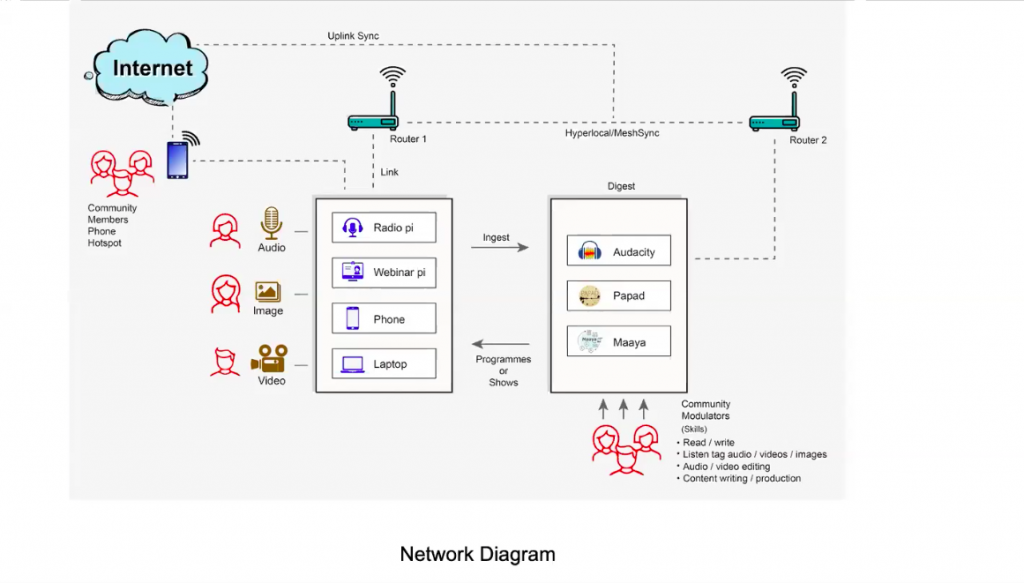
This allows people to not only contribute their knowledge and stories to the mesh network. It empowers people to organize and archive this shared knowledge so it’s discoverable, all without needing to be able to read or write. This shared hypermedia archive enables people to connect across similar interests, share recipes, and even offer gig services across the villages.
Dinesh’s projects emerge out of a passion for creating technology that is community maintained and developed. He believes in the potential of technology, combined with locally-available resources and knowledge, to bring about local futures that are more equitable and self-determining.
Reflections
As COVID spread throughout the world, even those in the most internet-connected, developed cities were susceptible to misinformation, conspiracy theories, and fake news. Here in the United States, COVID has exposed deep deficiencies in how we access accurate, reliable information, especially about what we each must do to mitigate this crisis in our communities.
The Global Fellows showed us how their communities are taking control of their network infrastructure, to make the information that is shared on their networks more relevant, accessible, and valuable for themselves. It’s easy to become disillusioned with the centralized, top-down, and profit-based systems that those of us in urban and developed areas have come to rely on for our news and information. Seeing how the Global Fellows are innovating to create homegrown technologies to address immediate information and education challenges is truly awe-inspiring.
What they are showing us is that “decentralization” is not only a matter of developing technology that is not centrally managed. It’s about building community, meeting people where they are, and approaching technology not as an end unto itself, but a means to address the real challenges that people face.